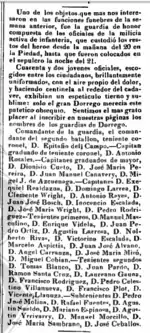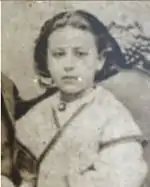Juan Manuel Canaveris
Juan Manuel Canaveris (1804-1868) was an Argentine jurist and politician, who served in Buenos Aires and Montevideo as attorney, teacher and military man. He participated of the escort of honor in the funerals of Manuel Dorrego,[1] and collaborated in the early days of government of Juan Manuel de Rosas.[2]
Juan Manuel Canaveris y Denis | |
|---|---|
| Personal details | |
| Born | May 10, 1804 Buenos Aires |
| Died | May 2, 1868 Buenos Aires |
| Resting place | Cementerio del Norte |
| Nationality | Argentine |
| Political party | Partido Federal (Lomo negro) National Party |
| Spouse(s) | Carmen Gutiérrez Moxica |
| Occupation | politician merchant farmer |
| Profession | jurist military man |
| Military service | |
| Allegiance | |
| Branch/service | Argentine Army |
| Years of service | 1819-1830 |
| Rank | Captain |
| Unit | Regimiento de Húsares Regimiento de Patricios |
| Battles/wars | Argentine Civil Wars Uruguayan Civil War |
He had an active participation as Procurador of the Argentine Nation, belonging to the moderate sector of the Federal Party linked to the political events that occurred during the Argentine and Uruguayan civil war.[3]
Military and political career

He was born in Buenos Aires, son of José Canaveris and Agustina Denis, belonging to a traditional family. He made his secondary studies in the National College and was graduated in law possibly at the University of Buenos Aires.
He was enlisted as a cadet in the Argentine Army in 1819, serving in the Regimiento Húsares de la Unión and Dragones Nueva Creacion. Two years later he was retired from active duty with a rank of Ensign.[4] Time later he was reincorporated and promoted to Captain, serving in the procession that accompanied the remains of Manuel Dorrego to the Cemetery of Recoleta.
It is very likely that Juan Manuel Canaveris has taken part in the end of the War of Independence. His incorporation is mentioned in a letter written by the General José Rondeau to Ignacio Álvarez Thomas.[5]
In 1830, he served as commander of the 2nd Regiment of Patricians of Buenos Aires.[6] He also had a military involvement serving in the Montoneras, a paramilitary militia of the Federal party. He served as General Assistant of Juan Manuel de Rosas during the Cañuelas Pact with Juan Lavalle in 1829.[7]
In 1832, he supported the government of Juan Ramón Balcarce, an opponent of Juan Manuel de Rosas. He belonged to the faction of the Federal party called as "Lomos Negros",[8] a political group who opposed the granting of extraordinary powers to Rosas as governor of Buenos Aires.[9]
Due to political issues Canaveris was forced into exile in Montevideo, where took part in meetings organized by Juan Bautista Alberdi and Valentín Alsina, about the French blockade of the Río de la Plata.[10]
He also suffered political persecution during his exile in the Banda Oriental, including during the period of the Great Siege of Montevideo. He had been accused by the Gobierno de la Defensa, of trying to enter the ranks of the General Manuel Oribe, being degraded to the rank of soldado raso with destiny to the artillería de la plaza of the Fortaleza del Cerro in 1843.[11]
He returned to Buenos Aires in 1849, living interchangeably between Montevideo and Buenos Aires until early 1860. As a supporter of the Uruguayan National Party, he opposed several Colorado leaders such as Melchor Pacheco y Obes and Joaquín Suárez, with whom he had a personal dispute.[12]
Other works
.png.webp)

His main activity in the territories of the Río de la Plata was as a criminal lawyer and fiscal of the city.[13] In 1833, he was appointed alternate member of the jury responsible to guarantee press freedom in the republic. The jury was composed of leading figures of the time as Juan Martín de Pueyrredón, Miguel de Azcuénaga, Tomás de Anchorena and Luis Dorrego.[14]
He was the author of Litis sobre un derecho de Tercería opuesto á la finca de propiedad de D. Antonio Maria Taboada, a book referring to a trial, published in the printing press of J. A. Bernheim in 1856.[15]
He had a distinguished service at the beginning of primary education in the United Provinces of the Río de la Plata. He served as teaching assistant in the Escuela de la Piedad, an educational establishments located in the neighborhood of San Nicolás.[16]
Juan Manuel Canaveris also was dedicated to trade and import, he had a warehouse in the Catedral street 153 (now San Martín).[17] He maintained economic ties with Hodgson & Robinson Co, textile importers from Manchester in Buenos Aires.[18] In 1826, he posted a notice in El Correo Nacional, offering for sale luxury shoes and several pounds of gunpowder.[19]
His business was located in the vicinity of the Faunch Hotel, the main English inn of the city, and where later was established the Bank of London and Río de la Plata.[20]
He also dedicated himself to buying and selling land and renting properties, in 1826 he acquired hectares near the Salado River, current town of Bragado.[21] He leased part of his property to several members of the Anglo-Argentine community of Buenos Aires, such as John Laing and Mathew Fouster, from Edinburgh and Dublin.[22] In 1834 part of his property was rented to James Nott, a hairdresser of English or Irish origin.[23]
He traveled on business matters to various cities of Europe, including Genoa[24] and Cadiz.[25]
Family

Juan Manuel Canaveris married on August 21, 1842 in The Parish Church of St. Francis of Assisi, to María del Carmen Gutiérrez, born in Montevideo, daughter of Juan Gutiérrez and Lorenza Moxica. He and his wife were the parents of Ángel Canaveris, a prestigious psychiatrist,[26] and Samuel Canaveris, who served as mayor of Río Gallegos in 1916 and 1917.[27]
.jpg.webp)
He and his family lived for many years in the house inherited from his paternal grandfather, located on Calle de la Piedad No. 21 and 27, neighborhood of San Nicolás. This place was known as the "barrio Inglés" (English neighborhood), due to the large number of English-speaking citizens who settled in the area since 1810.[28]
His grandson Carlos Manuel Canaveris, was a student in the Escuela de Maquinistas Navales directed by Carlos B. Massot.[29] He carried out an improvement course in Barrow-in-Furness, (United Kingdom).[30]
Juan Manuel Canaveris Denis died at the age of 64 on May 2, 1868, being witnesses Emilio Achinelly and Tomás Quincke.[31] Possibly he was a descendant of Irish Catholic families emigrated to France and Northern Italy in the early or mid 17th century. His descendants were linked to families of Enrique Yateman, Juan José Viamonte, José Fornaguera and Vicente Anastasio Echevarría.[32]
References
- El Lucero, diario político, literario y mercantil (1829–1833). (PDF), Imprenta Argentina (Acervo Digital)
- Columbus: Amerikanische Miscellen - Volumen2. Karl Nicolaus Röding. 1829.
- Con divisa blanca: cronica de la guerra uruguaya. Javier de Viana. 1904.
- Tomas de razón de despachos militares, cédulas de premio, retiros, empleos civiles y eclesiásticos, donativos, etc., 1740 a 1821. Archivo General de la Nación (Argentina).
- Catálogo de documentos del Museo Histórico Nacional, Volume 1. Ministo de Educación de la Nación. Dirección General de Cultura.
- Regimiento Patricios de Buenos Aires (PDF). El Lucero. Diario político.
- Columbus: amerikansiche Miscellen. 1825. 1825.
- Capítulo; biblioteca argentina fundamental, Volumes 10-11. Centro Editor de América Latina. 1967.
- Iconografía de Rosas y de la Federación, por F. Chávez. Juan A. Pradère. 1970.
- Escritos póstumos de Juan Bautista Alberdi: Miscelánea. Propaganda revolucionaria, 1900. Juan Bautista Alberdi.
- Los partidos de la República Oriental del Uruguay: estudio político-histórico-popular. Guillermo Melián Lafinur.
- Joaquín Suárez, "el gran ciudadano". Universidad de la República. 1978.
- Amalia ; novela histórica americana. José Mármol. 1930.
- Registro Oficial - Volumen12. Buenos Aires (Argentina : Province). 1833.
- Litis sobre un derecho de Tercería. Juan Manuel Canaveris. 1856.
- Acuerdos del extinguido Cabildo de Buenos Aires, Volume 9; Volume 47. Buenos Aires.
- Almanaque político y de comercio para 1826. Ediciones de la Flor.
- The British Textile Trade in South America in the Nineteenth. Llorca, Manuel. 18 April 1826. hdl:2381/9936.
- On sale. El Correo Nacional.
- Dicionario de Buenos Aires ó sea Guia de forasteros. República Argentina. 1864. p. 72.
Banco de Londres y Río de la Plata calle reconquista piedad buenos aires.
- Contribución a la historia de Bragado. Juan R. Moya. 1957.
- Argentina, Capital Federal, Census, 1855. Buenos Aires.
- Notice., The British Packet and Argentine News (November 1, 1834)
- Presencia y acción del Partido Nacional: aurora y ocaso. Macedonio Dell' Acqua Vieytes. 1953.
- Libros de ingreso de pasajeros a Montevideo (Libro No. 951 Años 1837 al 1838). Archivo General de la Nación - AGN/Uruguay.
- Revista del Instituto de Estudios Genealógicos del Uruguay, Issues 13-17. El Instituto, 1991.
- Patagonia documental, Issues 1-4, Argentina, Centro de Documentación Patagónica, 1974
- Historia de los barrios de Buenos Aires. Editorial Elche. 1998. ISBN 9789509921221.
- Colección de leyes y decretos militares concernientes al ajército y armada de la República Argentina : 1810 á 1896. Ercilio Dominguez.
- La Escuela de Maquinistas en Inglaterra, Caras y Caretas
- Defunciones 1868-1869. Nuestra Señora de La Merced.
- Nobiliario del antiguo virreynato del Río de la Plata. Carlos Calvo. 1936.